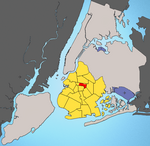Prospect Lefferts Gardens

Prospect Lefferts Gardens is a residential neighborhood in the Flatbush area of the New York City borough of Brooklyn. The community is bounded by Empire Boulevard (formerly Malbone Street) to the north, Clarkson Avenue to the south, New York Avenue to the east, and Ocean Avenue/Prospect Park to the west. Prospect Lefferts Gardens was designated a NYC Landmark area in 1979 and called the Prospect Lefferts Gardens Historic District.The neighborhood contains an ethnically diverse community with a largely Caribbean-American and African-American population. Since the 2000s, Prospect Lefferts Gardens has been gentrifying quickly. Real estate development has increased and new residents from other groups have increased.Prospect Lefferts Gardens is part of Brooklyn Community District 9, and its primary ZIP Code is 11225. It is patrolled by the 71st Precinct of the New York City Police Department. Politically it is represented by the New York City Council's 40th District.
Excerpt from the Wikipedia article Prospect Lefferts Gardens (License: CC BY-SA 3.0, Authors, Images).Prospect Lefferts Gardens
Midwood Street, New York Brooklyn
Geographical coordinates (GPS) Address Nearby Places Show on map
Geographical coordinates (GPS)
| Latitude | Longitude |
|---|---|
| N 40.66 ° | E -73.95 ° |
Address
Midwood Street 318
11225 New York, Brooklyn
New York, United States
Open on Google Maps





